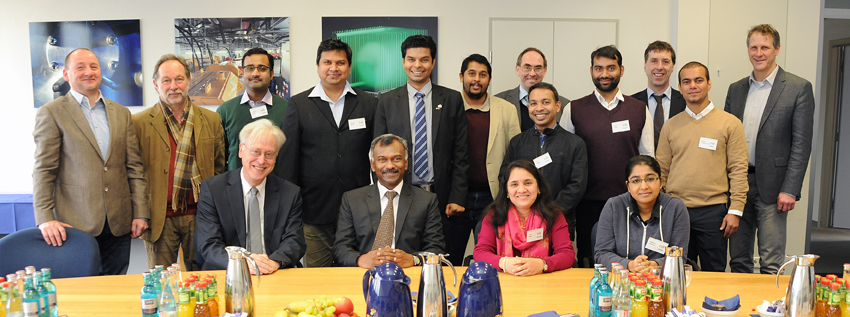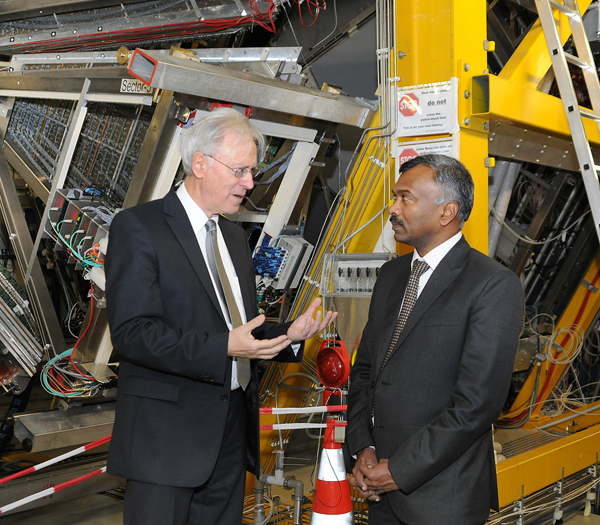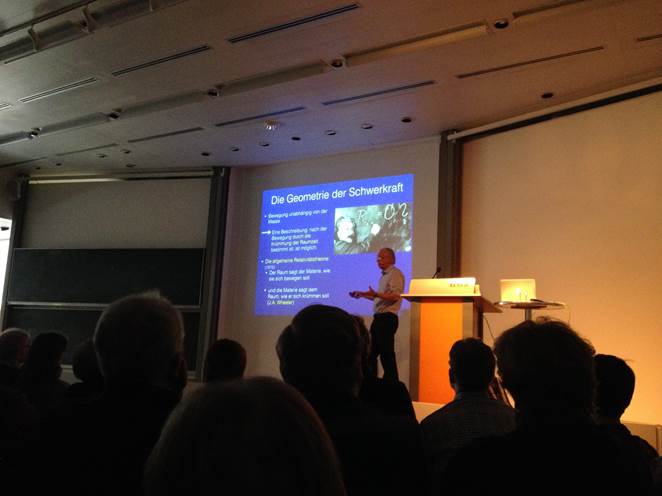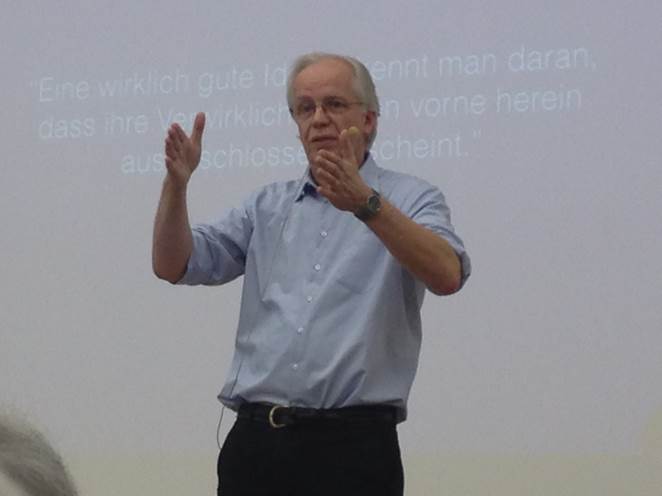Sie sehen momentan nur den öffentlichen Teil des GSI-Kuriers.
Um auch die GSI-internen Artikel angezeigt zu bekommen,
melden sie sich bitte an

Kurier - Mitteilungen von und für Mitarbeitende
Ausgabe: 08-2016 | 22.02. - 28.02.
Nachrichten
Nachrichten
Indischer Wissenschaftsattaché Rajachandran Madhan besucht FAIR und GSI

Der indische Wissenschaftsattaché Madhan (sitzend, 2. v. l.) besuchte FAIR und GSI. / The Indian Counsellor of Science and Technology (seated, 2nd from left) visited FAIR and GSI. (Foto: G. Otto)
Am Freitag, dem 5. Februar 2016, war der neue indische Wissenschaftsattaché Rajachandran Madhan aus der indischen Botschaft in Berlin zu Besuch bei FAIR und GSI. In seiner Funktion ist Madhan auch Mitglied des Administrative and Financial Committee (AFC). Seine Reise nach Darmstadt war sein erster Besuch einer Wissenschaftseinrichtung, seit er die Position als Wissenschaftsattaché übernommen hat. Er betonte während seines Besuchs die Wichtigkeit des FAIR-Projekts für Indien. Indien ist der drittgrößte Anteilseigner an FAIR nach Deutschland und Russland.

Professor Karlheinz Langanke (l.) erklärt Wissenschaftsattaché R. Madhan den HADES-Detektor. / Professor Karlheinz Langanke (l.) explains the HADES detector to counsellor R. Madhan. (Foto: G. Otto)
Madhan wurde von der Geschäftsführung von FAIR und GSI begrüßt. Anschließend erhielt er von Professor Karlheinz Langanke, Wissenschaftlicher Geschäftsführer von GSI, einen Überblick über den Status des FAIR-Projekts und in weiteren Vorträgen über die Kooperationen mit Indien. Anschließend informierte er sich bei einem gemeinsamen Mittagessen mit indischen Studenten und Wissenschaftlern über die wissenschaftlichen Arbeiten und die Ausbildung auf dem Campus. Auf einem Rundgang durch die bestehenden Anlagen besuchte er die Beschleuniger, den Green IT Cube, den HADES-Detektor, den Therapieplatz sowie das FAIR-Baufeld.
Indian Counselor of Science and Technology Rajachandran Madhan visits FAIR and GSI
On Friday, February 5, 2016, the new Indian Counsellor of Science and Technology Rajachandran Madhan from the Indian Embassy in Berlin visited FAIR and GSI. In this role Madhan is also a member of the Administrative and Financial Committee (AFC) of FAIR. His journey to Darmstadt was the first visit to a scientific facility since he took over as counsellor. He emphasized the importance of the FAIR project to India during his visit. India is the third largest shareholder of FAIR following Germany and Russia.
Madhan was welcomed by the FAIR and GSI management. Furthermore he received information about the status of the FAIR project by Professor Karlheinz Langanke, Scientific Director of GSI, and, in additional talks, about the cooperation with India. In a joint lunch with Indian students and scientists he got to know about the research and education on the campus. Afterwards he visited the accelerators, the Green IT Cube, the HADES detector, the therapy facility and the FAIR construction site.
C. Pomplun, Öffentlichkeitsarbeit, Tel. 1442
Überragendes Interesse beim Sondervortrag von Bengt Friman über Gravitationswellen


Professor Bengt Friman beim Vortrag / Professor Bengt Friman at the talk (Foto: GSI)
Auf außerordentlich großes Interesse stieß der Vortrag über Gravitationswellen von Professor Bengt Friman, dem Leiter der GSI-Forschungsabteilung „Theorie“. Über 300 Gäste und Beschäftige besuchten am 18. Februar seinen exzellenten Vortrag, in dem er anschaulich die Eigenschaften und den Nachweis von Gravitationswellen erläuterte und außerdem den Bezug zur astrophysikalischen Forschung an den Beschleunigeranlagen von GSI und FAIR aufzeigte. GSI und FAIR hatten kurzfristig zu dem Vortrag im Rahmen der öffentlichen Vortragsreihe „Wissenschaft für alle“ eingeladen, nachdem die Woche zuvor in den USA erstmals der direkte Nachweis von Gravitationswellen gelang.
Friman berichtete in seinem Vortrag „Gravitationswellen – Kräuselungen der Raumzeit“ über den von der LIGO-Kollaboration in den USA vermeldeten ersten direkten Nachweis von Gravitationswellen. Er erläuterte die Grundlagen zur Entstehung der Wellen, die Albert Einstein bereits vor 100 Jahren vorhergesagt hatte. Anschließend berichtete er über mögliche Messmethoden und den zuvor erfolgten indirekten Nachweis mithilfe von Pulsaren. Die aktuelle Messung von Gravitationswellen ging auf eine Verschmelzung von zwei schwarzen Löchern zurück. Weitere mit terrestrischen Interferometern nachweisbare Quellen von Gravitationswellen könnten schnell rotierende Neutronensterne, Supernovae sowie Doppelsysteme aus Neutronensternen sein. Bengt Friman demonstrierte die aktuellen Messungen der LIGO-Kollaboration im Vergleich mit Simulationen und gab einen Ausblick über die Forschung an den Beschleunigeranlagen von GSI und zukünftig an FAIR, mit dem die Erzeugung von Materie, wie sie etwa im Inneren von Neutronensternen existiert, möglich sein wird.
Extraordinary interest in special talk by Bengt Friman about gravitational waves
The talk on gravitational waves by Professor Bengt Friman, head of the GSI research department "Theory", received extraordinary interest. More than 300 guests and employees visited his excellent talk on February 18, where he vividly explained the properties and the observation of gravitational waves, and illustrated the relation to the astrophysical research at the accelerator facilities at GSI and FAIR. The talk was announced on short notice in the public lecture series "Wissenschaft für Alle” at GSI and FAIR, following the report on the direct observation of gravitational waves in the USA one week earlier.
In his talk "Gravitationswellen – Kräuselungen der Raumzeit", delivered in German, Bengt Friman reported on the direct observation of gravitational waves by the LIGO collaboration in the USA. He described the basic principles behind the generation of the waves, which were predicted by Albert Einstein already 100 years ago. Subsequently, he described possible observational methods as well as the earlier indirect detection of gravitational waves in a binary pulsar system. The current gravitational-wave event emanated from a collision of two black holes. Other sources of gravitational waves that may be detected with terrestrial interferometers are fast rotating neutron stars, supernovae as well as binary systems of neutron stars. Finally, Bengt Friman presented the current oberservation of the LIGO collaboration in comparison with simulations and gave an outlook on research at the accelerator facilties at GSI and, in the future, at FAIR, where the production of matter similar to that in the interior of neutron stars will be possible.
C. Pomplun, Öffentlichkeitsarbeit, Tel. 1442
Reminder: GSI Scientific Report 2015
Dear Colleague,
GSI operates a large-scale worldwide unique accelerator facility for heavy ions, which offers outstanding opportunities for research in the fields of hadron and nuclear physics, atomic physics, dense plasma research, material science, biophysics, and radiation medicine. As every year, the GSI Scientific Report illustrates the richness and excellence of the research performed at our institute. In relation to the scientific work done at and for GSI and the future FAIR facility in 2015, all scientists are invited to contribute to the GSI Scientific Report 2015 with scientific results, methodological developments and instrumental achievements.
Please submit your abstract until March 21th and your final contribution March 31th:
https://indico.gsi.de/event/sr-2015
Detailed instructions and templates for LaTeX and Word are provided on the above mentioned website. You are not allowed to change those templates or to re-use contributions from other publications like progress or annual reports. The contributions will undergo a review procedure with respect to layout and content prior to publication. The review phase will be completed on April 30th. The final report will be published online in the GSI repository: DOI:10.15120/GR-2016-1 . The GSI Scientific Report 2014 is available at: https://repository.gsi.de/record/185629 . For questions please contact (sr-2015@gsi.de or +496159 71-2610).
Thank you for supporting the GSI Scientific Report!
Thomas Stöhlker
K. Große, BuD , Tel. 2610
Die aktuellen internen Stellenausschreibungen finden Sie auch unter www.gsi.de/jobsintern
Gruppe PER-PAD










